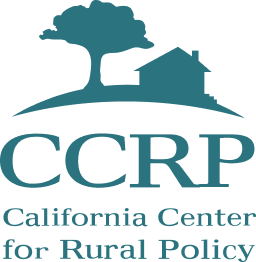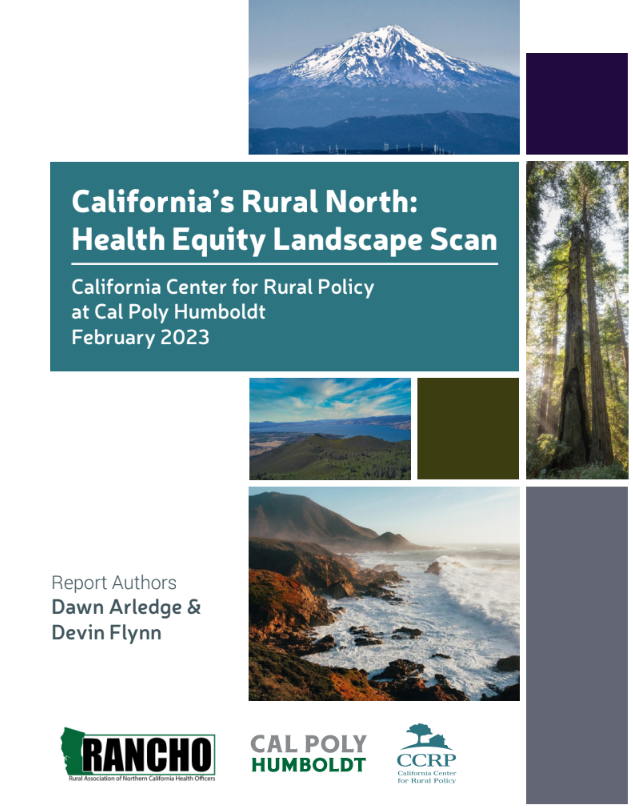California's Rural North: Health Equity Landscape Scan provides a snapshot of where the RANCHO region is at with efforts around health equity, equity in the Public Health workforce, building trust and engaging communities in the region, data and measurement challenges commonly tied with rural communities. and learning needs for the region to advance health equity in their communities. The report also communicates certain levels of disparity within the region, as they pertain to barriers of health equity.
To access and download the report, please click on the image of the report cover to the right:
Executive Summary
California’s far north region is sparsely populated and topographically intricate. The counties that comprise the RANCHO region comprise about 2 percent (701,548) of California’s total population but roughly 21.6 percent (35,291 sq. mi.) of California’s total land area. All eleven of the counties are among the most rural counties in California.
Key Findings
Health Disparities
RANCHO counties consistently rank below most other counties in the state on key health outcome measures related to length and quality of life. In 2022, nine of the eleven RANCHO counties fell within the lowest quartile of the health outcome rankings across the state.
LHDs in the RANCHO region have identified similar concerns in county-level community health assessments: Lack of housing, limited access to health care and behavioral health care, socioeconomic disadvantage, geographic isolation, and high-risk health behaviors.
LHDs highlighted health disparities for the following groups: Tribal populations, Latinx populations, populations living in poverty, aging populations, those who are geographically isolated, and those who are experiencing substance use or mental health issues.
Behavioral health–including substance use and suicide–are cited as contributing factors for morbidity and mortality in the RANCHO region.
Health Equity Efforts
Both RANCHO and the rest of the state’s LHDs report being in the early stages of health equity efforts. Funding from CDPH is allowing RANCHO LHDs to advance this work.
LHDs in the RANCHO region are working to create more equity infrastructure within their departments and agencies with the long-term goal of advancing equity in their communities.
RANCHO counties are currently working to embed health equity efforts into basic organizational functions such as recruitment, retention, outreach, and service delivery. RANCHO LHDs are updating or creating strategic plans, communications plans, and language access plans as well as developing equity checklists, and creating and participating in equity-based affinity groups and spaces.
Public Health Workforce
The structure and size of the LHDs across the RANCHO region vary greatly. LHDs in the region roughly range from 16 to 230 full-time employees. However, despite variations in structure and size, LHDs have similar funding streams and programs.
Turnover, a lack of qualified applicants, and housing shortages make recruitment and retention of the Public Health workforce difficult. These are common workforce challenges across the region.
Specialty positions that are difficult to staff and/or recruit across the region include: Health Officers, Public Health Nurses, and Epidemiologists. RANCHO LHDs reported challenges in staffing across other classifications as well.
LHDs in the RANCHO region want to expand academic partnerships that help students find their way to careers in Public Health. LHDs in the region want to create career ladders for entry-level positions so those positions have advancement opportunities. Other ideas generated for workforce development include creating a paid internship program with the county government, establishing Community Health Worker certification pipelines, and establishing two-year entry level Public Health associate's degree programs.
Trust Building and Community Engagement
RANCHO counties rely on collaboration with community partners to expand the reach and scope of efforts to advance health equity. Currently, RANCHO’s efforts center around four primary strategies to engage communities across the region:
Strategic community and/or Tribal partnerships for a specific purpose (i.e. vaccination clinics, health fairs).
Facilitation and participation in community-wide coalitions focused on health.
Community-wide outreach and education including media outreach and trainings.
Utilization of Community Health Workers (or equivalent positions) that are embedded within specific geographic regions and/or have experience with a specific population that experiences health disparities.
Data & Measurement Challenges in a Rural Region
RANCHO has a high level of interest in data equity and in the identification of metrics that are meaningful for small rural counties. Multiple RANCHO counties expressed concern they did not have adequate data to drill down on populations or regions that experience health disparities.
Rural counties face unique challenges around availability and usefulness of population-level data. Small sample sizes and multi-county data aggregations make analysis of certain metrics unreliable and inconclusive.
Epidemiologist positions are difficult to staff and many RANCHO counties do not have full-time Epidemiologists.
Resource and Learning Needs
There are various training, technical assistance, and peer learning topics RANCHO has identified that are pivotal to improving health equity and furthering COVID-19 recovery in the region.
Based on survey data, one-on-one interviews with counties, and a review of RANCHO meeting minutes, CCRP developed a preliminary learning needs summary and plan (see Figure 28) to bring training and technical assistance to RANCHO.
Learning needs summary topics are categorized as they relate to the four focus areas of CCRP’s work plan:
Coordinate Region LHD Equity COVID-19 Response and Recovery Efforts (Category: Health Equity).
Build a Foundation for Pursuing Equity Work within Communities (Category: Community Engagement).
Adopt Regional Data and Measurement Standards (Category: Data & Measurement).
Equity in the Public Health Workforce (Category: Workforce Development).

